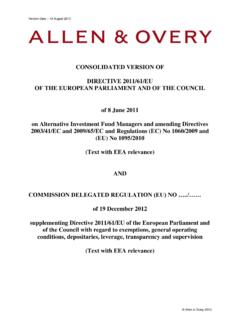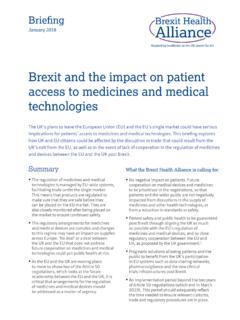Transcription of UK covered bonds a head start on the key …
1 brexit legal consequences for commercial parties UK covered bonds a head start on the key considerations and possible implications May 2017. Issue in focus Since the first UK covered bond transaction in 2003, In this article we identify certain key considerations for and following the introduction of the national statutory UK covered bonds arising as a result of brexit , and framework in 2008, a mature covered bond market has seek to provide a head start for our clients in analysing developed in the UK. This market has allowed UK the possible implications and what they may mean in banks and building societies to diversify and expand practice. It should be noted that how the UK. their funding sources, and covered bonds have Government legislates for brexit and the nature of the provided a reliable source of funding throughout future relationship between the UK and the EU are periods of market stress. The importance of covered fundamental elements of the relevant analysis and may bonds across Europe has been expressly acknowledged shape certain outcomes.
2 The outcome in respect of the by the EU Commission through its Capital Markets CMU initiative and the position of UK issuers under Union (CMU) initiative and the corresponding the expected new EU regulatory framework for workstream on the development of a new pan- covered bonds is also key. European regulatory framework for a more integrated This article is one of a series of specialist Allen &. covered bond market. Overy papers on brexit . To access these papers, please visit Allen & Overy LLP 2017 1. brexit | UK covered bonds a head start on the key considerations and possible implications | May 2017. Key considerations and It may be possible to avoid this outcome if changes are made to the relevant EU laws to accommodate covered Analysis bonds involving third country issuers. Helpfully, there is some possibility of changes being made in this regard. It has been suggested in the context of the possible unlevel playing field from a CMU initiative and related discussions on the regulatory perspective development of the new EU regulatory framework for covered bonds that certain third country arrangements covered bonds benefit from preferential regulatory could be recognised and also benefit from preferential treatment under the current EU framework.
3 Since the regulatory treatment under EU laws. introduction of the national statutory framework in 2008, UK regulated covered bonds have been on a In particular, in communications relating to the CMU. level playing field with more traditional EU covered initiative, each of the Commission and the European bond products in that they benefit equally from this Banking Authority has referred to possible expansion better treatment. However, brexit could result in a of the key features applied to identify covered bonds shift in the current position, meaning that UK covered for EU regulatory purposes to accommodate those bonds may once again face a competitive disadvantage, issued by certain third country issuers. In each as they did prior to 2008. instance, such expansion has been described to be appropriate for equivalent arrangements only and By way of background, the preferential treatment subject to the establishment of a suitable mechanism afforded to covered bonds under the current EU for assessing this.
4 It remains to be seen whether the framework is apparent in the adjusted treatment EU authorities will pursue any additional flexibility provided on a number of fronts. For example, less with respect to the location of issuer establishment as restrictive rules apply to EU regulated funds with part of the expected new regulatory framework. respect to exposures to covered bonds , reduced capital Further information on the framework is expected to be requirements apply to EU regulated credit institution published in mid-2017 as part of the CMU mid-term and insurer investors in respect of covered bond review process. positions and provisions apply to allow covered bonds to be eligible as Level 1 assets for EU regulated credit If UK covered bonds are no longer able to benefit from institutions for liquidity coverage ratio purposes. In better regulatory treatment in the hands of relevant EU. addition, certain conditional relief is provided from the regulated investors, relative disincentives to investing clearing and margin requirements under the EU Market in UK bonds may arise for these investors.
5 Infrastructure Regulation (EMIR) for covered bond It is unclear what regulatory treatment covered bonds swaps. will be subject to after brexit in the hands of UK. However, in order to benefit from these adjustments, regulated investors and whether the UK authorities relevant bonds are required in all cases to demonstrate may provide for better treatment for certain covered the key features set out in article 52(4) of the EU bonds , including UK regulated covered bonds . That UCITS Directive, and to also satisfy certain additional said, based on the intention on the part of the UK. requirements ( with respect to the cover pool assets) Government via the Great Repeal Bill to covert EU law for specific regulatory purposes. Among other things, as it stands at the moment of exit into UK law, we article 52(4) of the UCITS Directive requires expect the same or similar preferential treatment to qualifying bonds to be issued by a credit institution continue to apply in the UK upon withdrawal, with any with its registered office in the European Economic adjustments considered necessary for sensible function.
6 Area (EEA). As a result, given recent statements by Lastly, we note that, in the longer-term, brexit is likely the UK Government indicating that the UK will not to result in a growing divergence between the remain part of the EEA and given that the UK statutory regulatory regime which applies in the UK and that framework requires use of a domestic issuer, brexit which applies in the EU. Given the inherently cross- may mean in effect that UK regulated covered bonds border nature of the covered bond markets and the fact are no longer able to satisfy this requirement. that certain regulatory requirements and provisions are 2 Allen & Overy LLP 2017. brexit | UK covered bonds a head start on the key considerations and possible implications | May 2017. investor-focused, such divergence may give rise to common law principles. While there is uncertainty as increasing regulatory considerations for UK covered to some aspects of English law while the precise terms bonds .
7 Of exit from the EU are negotiated and the Great Repeal Bill is developed, principles of English Expected general consistency in UK common law as they apply to support the basic legal statutory framework analysis in respect of UK covered bond transactions (including concepts related to general contract law, The current UK statutory framework for covered bonds trusts, asset assignments and security) should be cross-refers to and reflects certain principles derived largely unaffected. As a result, the UK covered bond from the EU regulatory regime. These points of structure should continue to function as it has done to consistency are deliberate and operate in certain date and material concerns related to legal certainty respects to facilitate compliance on the part of UK should not arise. issuers with the requirements applicable for the preferential treatment of regulated covered bonds under In certain other respects, the Great Repeal Bill should such EU regime.
8 Assist with smoothing the legal transition, through converting EU law as it stands as at the moment of exit While brexit may result in a general review of these into UK law. This will function more sensibly in the cross-references, we expect any corresponding updates case of certain EU laws ( those which do not form or amendments to the UK statutory framework to be part of a cross-border legal framework intrinsically relatively contained. This is in part due to our linked to reciprocity or hinge in their operation on understanding that the current regime is considered by other EU concepts or infrastructure) and present the authorities to function as intended in general and challenges in the case of others. The latter case is also due to the fact that the requirements for covered likely to include EU cross-border legal frameworks bonds which apply at an EU level (including under related to coordination and recognition as between article 52(4) of the UCITS Directive) are largely Member States.
9 Principles-based, meaning that the UK authorities were able to exercise significant discretion in setting the For example, the Insolvency Regulation would cease to terms of the current UK regime. In this regard, we note operate to fully ensure cross-border coordination and that the authorities have undertaken a review of the UK recognition of insolvency proceedings without a framework since its introduction and concluded in that replacement reciprocal arrangement being agreed with context that only a handful of changes were required. the EU, and similar considerations would arise in respect of the Credit Institutions Winding Up Directive Notwithstanding the foregoing and despite (rather than and Bank Recovery and Resolution Directive regimes. as a result of) brexit , if the EU authorities pursue the In any event, we would not expect material issues to adoption of the expected new framework for covered arise as a result of the cessation in application of any of bonds as part of the current CMU workstream and the these frameworks, particularly given that UK covered regulatory treatment of covered bonds in the hands of bond structures do not typically involve a relevant relevant EU regulated investors is tied to compliance cross-border connection.
10 With this (and third country issuer bonds are eligible in principle as discussed above), then the UK authorities possible shifts in issuer and may consider making corresponding adjustments to the national regime if this would result in a level playing counterparty strength field for UK covered bonds . General concerns have been raised by a number of market analysts that the increased uncertainty arising as General consistency in law and basic a result of brexit may lead to financial and economic legal analysis volatility in the UK, which may in turn result in increased stress for UK market participants and a The structure used in UK covered bond transactions is corresponding reduction in the financial strength of reflected in the national statutory framework but pre- such entities. Some analysts have also predicted higher dates this and is based on securitisation technology in stress levels for UK institutions, particularly those less part.













